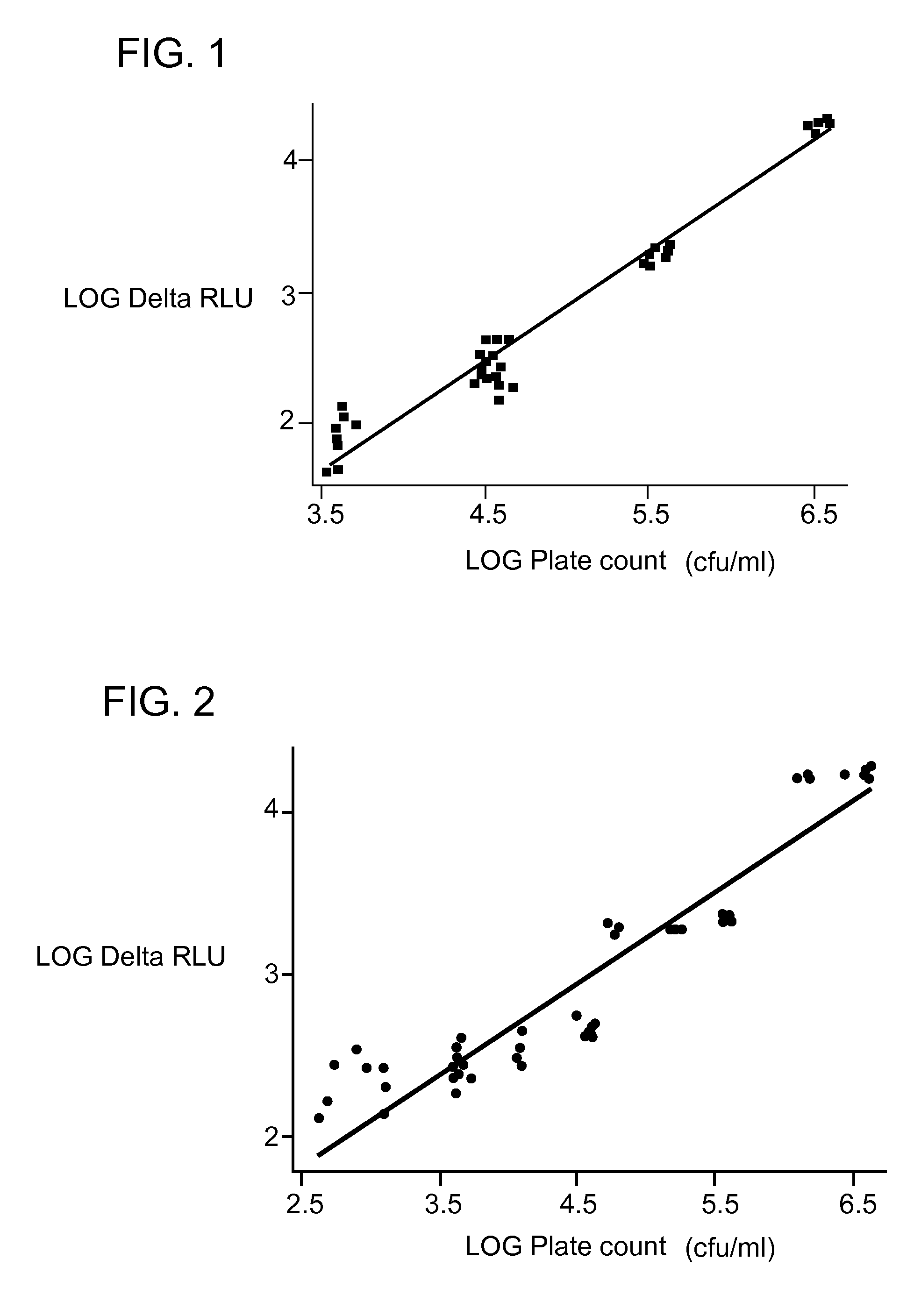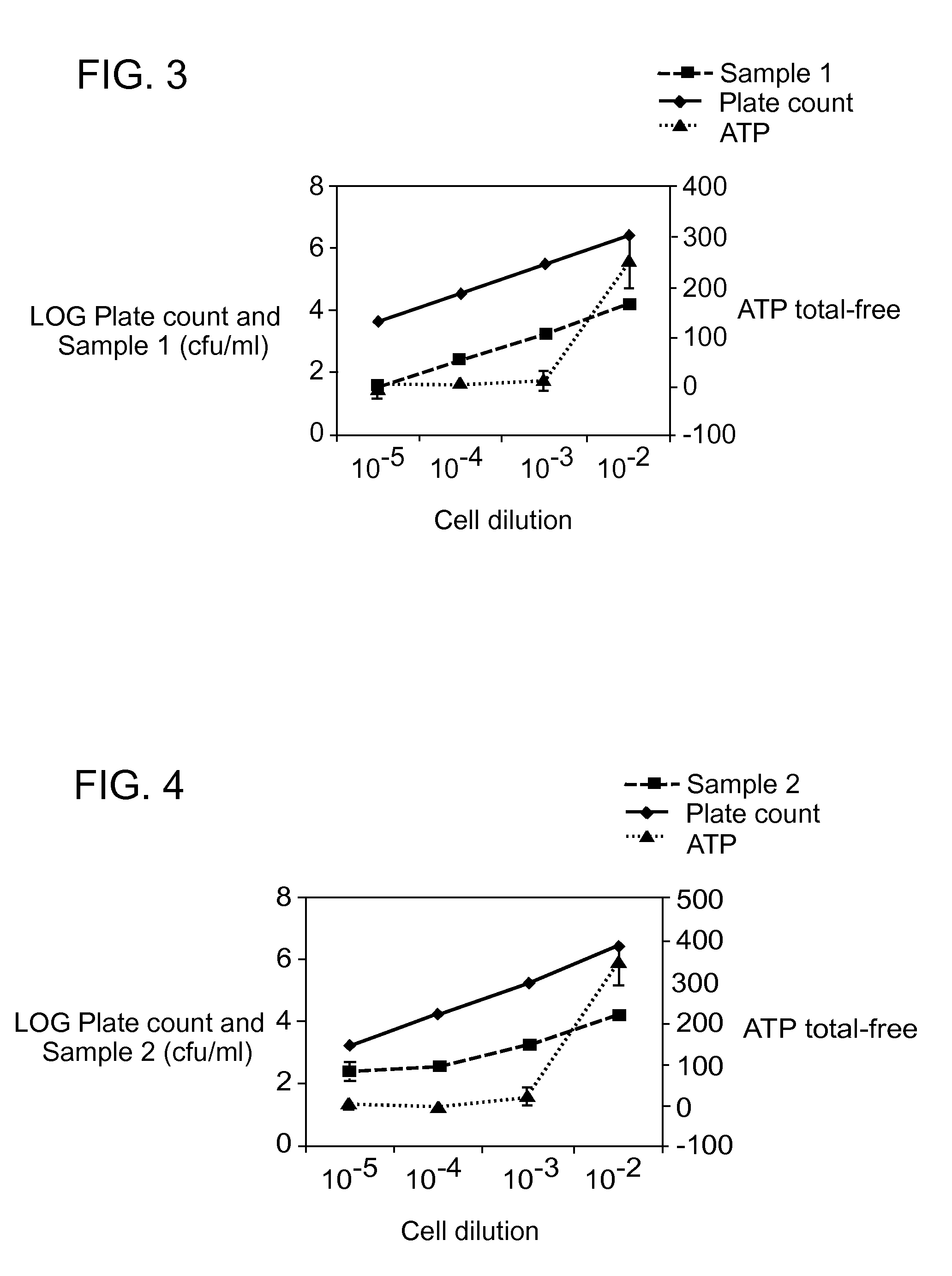Methods for measuring microbiological content in aqueous media
a technology of microorganisms and aqueous media, applied in the field of fluorescence-based assays, can solve the problems of health risks, affecting the operation cost of the system, shortcomings and defects of both, and achieves the effects of low cost, high degree of sensitivity, and convenient us
- Summary
- Abstract
- Description
- Claims
- Application Information
AI Technical Summary
Benefits of technology
Problems solved by technology
Method used
Image
Examples
example 1
Calibration Curve in Phosphate Buffer Saline (PBS):
[0064]Pseudomonas fluorescens cells were grown over night in a liquid culture media and added to 10 ml of PBS to form an initial sample. Serial dilutions were prepared from the initial sample. 0.1 ml of the initial sample was added to 9.9 ml of PBS to make a 1% (10−2) solution. 1 ml of the 1% solution was added to 9 ml of PBS to make a 0.1% (10−3) solution. 1 ml ofthe 0.1% solution was added to 9 ml of PBS to make a 0.01% (10−4) solution. 1 ml of the 0.01% solution was added to 9 ml of PBS to make a 0.001% (10−5) solution. 10 ml of the PBS was used for a cell-free blank
[0065]170 μl samples were taken from each of the diluted samples and the cell-free blank and each sample was mixed with 20 μl of 10× SYBR® Green I dye and 10 μl of 20× CyQUANT™ cell lysis buffer (available commercially from Molecular Probes). Fluorescence intensity was measured for each of the samples (cell-free blank, 10−2, 10−3, 10−4 and 10−5) at an excitation wavel...
example 2
[0070]A calibration curve was prepared as in Example 1 except that filtered water from a cooling tower was used instead of the PBS.
[0071]About 50 ml of water from a cooling tower was filtered through a PVDF filter (Millipore SLGV033RB) to remove residual microorganisms. 10 ml of the filtered water was used for a cell-free blank
[0072]Concentrations of the total Pseudomonas fluorescens bacteria were obtained for each sample (cell-free blank, 10−2, 10−3, 10−4 and 10−5) by the plate count method.
[0073]Regression analysis was performed between the log value of the delta fluorescence intensity (RLU) and the log value of the plate count (cfu / ml) to obtain a calibration curve as shown in FIG. 2. The regression equation is y=0.383+0.576×(R−Sq=90.7%).
example 3
[0074]Pseudomonas fluorescens cells were grown over night on a culture plate and added to several 170 μl samples of phosphate buffer saline. Each sample was mixed with 20 μl of 10× SYBR® Green I dye (from Molecular Probes) and 10 μl of 20× CyQUANT™ cell lysis buffer.
[0075]Fluorescence intensity was measured for each of the samples at an excitation wavelength of 497 nm and an emission wavelength of 520 nm. The fluorescence was measured four times for each sample and averaged to obtain a fluorescent baseline signal.
[0076]The samples were heated at 60° Celsius for 2 minutes and then cooled down to room temperature. Fluorescence intensity was measured for each of the samples at an excitation wavelength of 497 nm and an emission wavelength of 520 nm. The fluorescence was measured four times for each sample and averaged to obtain a second fluorescent signal.
[0077]A delta fluorescence intensity (Δ) was obtained by subtracting the fluorescent baseline signal from the second fluorescent sign...
PUM
| Property | Measurement | Unit |
|---|---|---|
| emission wavelength | aaaaa | aaaaa |
| emission wavelength | aaaaa | aaaaa |
| temperature | aaaaa | aaaaa |
Abstract
Description
Claims
Application Information
 Login to View More
Login to View More - R&D
- Intellectual Property
- Life Sciences
- Materials
- Tech Scout
- Unparalleled Data Quality
- Higher Quality Content
- 60% Fewer Hallucinations
Browse by: Latest US Patents, China's latest patents, Technical Efficacy Thesaurus, Application Domain, Technology Topic, Popular Technical Reports.
© 2025 PatSnap. All rights reserved.Legal|Privacy policy|Modern Slavery Act Transparency Statement|Sitemap|About US| Contact US: help@patsnap.com



